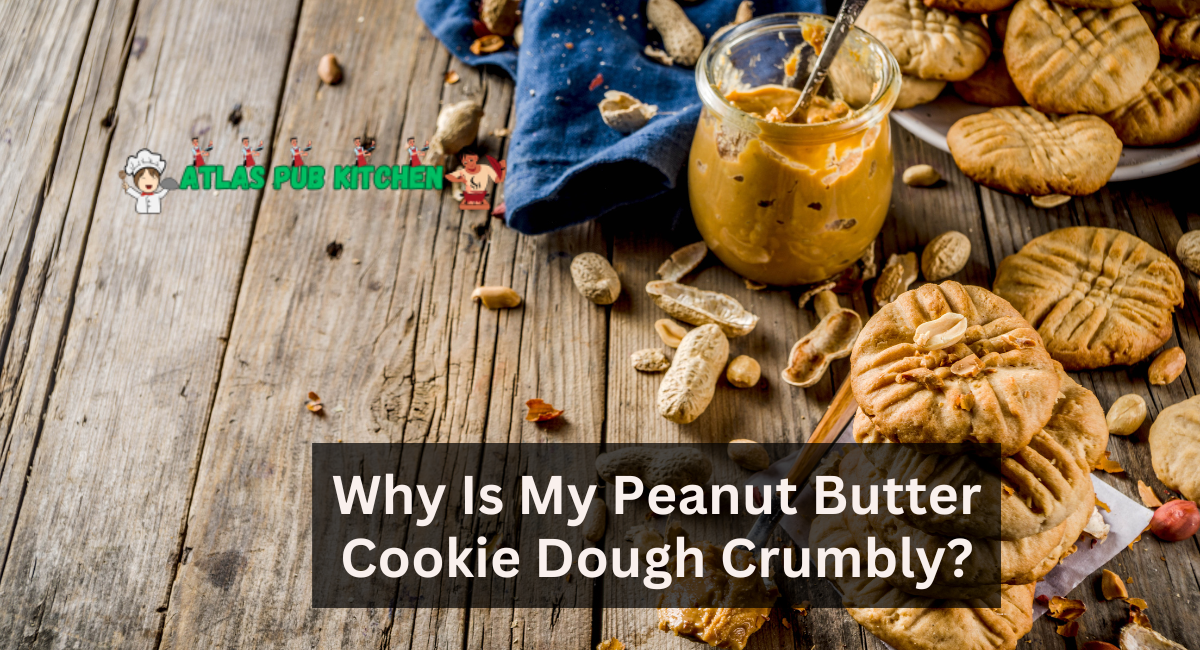Peanut butter biscuits, with their signature nutty flavor and melt-in-your-mouth texture, are a popular dessert. However, the pleasure of creating these delicious cookies can be diminished when the cookie dough is crumbly and difficult to work with.
In this article, we will explore the crucial factors that affect the texture of peanut butter cookie dough and decipher the common causes behind this culinary conundrum. Understanding these factors will enable you to troubleshoot and perfect your cookie-making procedure, ensuring that your peanut butter cookies are as tender, moist, and delicious as you desire.
Why Is My Peanut Butter Cookie Dough Crumbly?
Here are the reasons why the Peanut Butter Cookie Dough Crumbly:-
- Peanut Butter Texture: Using dried or natural peanut butter, which has less oil and moisture, can cause crumbly.
For a smoother pastry, choose creamy peanut butter with added oils. - Proportion of liquid to dry ingredients: An improper ratio of wet (such as peanut butter and eggs) to dry (such as flour) constituents can result in dry dough.
Adjust the recipe by adding more liquid ingredients or decreasing the amount of dried ingredients. - Excessive mixing: When the dough is overmixed, the lipids (such as butter) can break down, resulting in a crumbly texture.
Mix the dough until it is just combined to prevent overmixing. - Flour Quantification: If the flour is measured incorrectly (using a heavy hand or scooping directly from the container), the dough may contain too much flour.
Utilize the spoon and level approach to measure flour accurately. - Dry Conditions: When dough is baked in an arid climate, it can become crumbly.
Adjust the recipe by adding a touch more liquid to compensate for the dryness.
Why Are My Cookies Crumbling?
There are a few reasons your peanut butter cookies might need to be dry and crumbly. One reason could be that you overcooked them. Peanut butter cookies should be lightly browned on the edges and just set in the center. If they are overcooked, they will be dry and crumbly.
Another reason your peanut butter cookies might be dry and crumbly is that you need to add more moisture to the dough. Peanut butter is a dry ingredient, so you need to add some wet ingredients, like milk or eggs, to balance it out. If your dough is too dry, your cookies will be dry and crumbly.
Finally, your peanut butter cookies might be if using natural peanut butter, the cookies are dry and crumbly. That doesn’t have any added oil. Natural peanut butter tends to be drier than regular peanut butter, so it can make your cookies dry and crumbly. If you want to use natural peanut butter, make sure to add an extra tablespoon or two of oil to the dough to compensate.
What Happens If You Add Too Much Peanut Butter to Your Cookies?
The peanut butter cookies are a crowd-pleaser, so you should incorporate as much of your favorite spread as feasible. Peanut butter adds a great deal of value to baked products by imparting a salty, nutty flavor, a light golden hue, and a healthy dose of sugar’s sweetness. It also contains a sufficient amount of lipids. A 100-gram serving of peanut butter contains a whopping 51,4 grams of fat, which contributes to its chewiness and makes it a healthier alternative to butter in baked products.
It’s easy to presume that you should pack your recipe with as much peanut butter as possible to achieve maximum flavor and chewiness, but getting the peanut butter-to-other-ingredients ratio just right is essential for your cookies to have the desired texture. A serving of smooth, unsalted peanut butter contains 3.56 grams of carbohydrates per 100 grams. This may not seem like much, but it is enough to impact the quality of your cookies; adding too much peanut butter will make them dry, crumbly, and hard.
Too Much Peanut Butter Leads To Dry Cookies?
Peanut butter’s protein may also be to blame, as it provides structure to baked products but can also absorb moisture, resulting in a dry texture. Use no more than one cup of peanut butter for every one and a half cups of flour and one-fourth cup of butter to achieve maximum peanut flavor while maintaining soft cookie consistency. You will receive the optimal proportions of saturated, unsaturated, and gluten.
Depending on the type of peanut butter you use, you may need to add a step to ensure the correct texture in your pastry. Using natural peanut butter in baking is perfectly acceptable, but it must first be thoroughly mixed. If you add it while the liquid and solids are still separated, your biscuits may need to be more oily or undercooked. Additionally, choose an entirely creamy spread. There is a time and a place for chunky peanut butter, but there may be better options for peanut butter cookies due to its tendency to add too much texture. Whether you choose natural or conventional peanut butter, be careful when incorporating it into your cookie dough.
How Do You Moisten Dry Peanut Butter Cookie Dough?
The simplest way to moisten dry peanut butter cookie dough is to incorporate a liquid ingredient. Any liquid, including butter, oil, or even a few teaspoons of milk, can be used to moisten the dough.
Add one tablespoon of liquid while stirring until the desired consistency is reached. If the dough is still too wet, you may also need to incorporate a touch of flour. If the dough is too dry, add small amounts of liquid and mix until the desirable consistency is reached.
How Do You Make Cookies Soft And Chewy?
To produce cookies that are tender and chewy, cream the butter before adding the sugar. This helps to aerate the butter and creates a delicate texture by creaming it with sugar. You should also use brown sugar instead of white sugar, as the molasses in brown sugar will keep the cookies tender and moist.
In addition, you should substitute an egg yolk for a whole egg because the yolk adds more moisture to the mixture. To prevent overworking the dough, the flour should be incorporated gently and steadily.
Use a baking time near the lower end of the recommended range to prevent the cookies from becoming overly brittle. This will ensure that they remain soft as they chill
How to Fix Crumbly Sugar Cookie Dough?
- Assess the dough: inspect the dough closely to determine the degree of crumbliness. It may be desiccated and poorly held together.
- Add additional fat (butter or oil): fat enables the dough to bind. Add additional softened butter or neutral oil (such as vegetable or canola oil) to the dough in increments. Start by adding a tablespoon of flour at a time and thoroughly combining until the dough begins to bind.
- Add a little liquid: add small quantities of liquid to the dough, such as milk or water. Beginning with a teaspoon, combine thoroughly after each addition. Be careful not to add too much liquid, as this may cause the battery to become too sticky.
- Incorporate an egg: beat an egg and progressively incorporate it into the dough while thoroughly mixing. The egg’s moisture helps to bond the ingredients together.
- Use cream cheese or yogurt: add a small portion of cream cheese or plain yogurt to dough. These ingredients contribute moisture and enable the dough to come together.
- Knead the dough: place the crumbly dough on a clean surface and knead it with your hands until smooth. The warmth of your hands can aid to soften and bind the dough.
- Adjust the flour-to-fat ratio: adjust the flour-to-fat ratio if the dough is excessively crumbly. To balance the dough, you may need to add a touch more fat (butter or oil).
- Ensure proper combining: sometimes, dough that is crumbly is the result of improper combining. Ensure that the ingredients are thoroughly combined, distributing the lipids and liquids evenly.
What Can You Do with Dry Cookies?
There are numerous uses for dry biscuits! One popular option is to crumble them up and use them as a garnish for ice cream. As a special treat, crush your beloved cookies and add a few sprinkles. Cookies can also be used to create a variety of homemade trail mixtures.
Add almonds, raisins, and your preferred dried fruit for a snack that is certain to please. Try crumbling up some dry biscuits and incorporating them into a freshly baked batch of brownies or frosted cupcakes.
You can also try crumbling dry biscuits and incorporating them into savory dishes such as shepherd’s pie or macaroni and cheese. You can go right with dried cookies if you are creative!
Thanks for reading.










